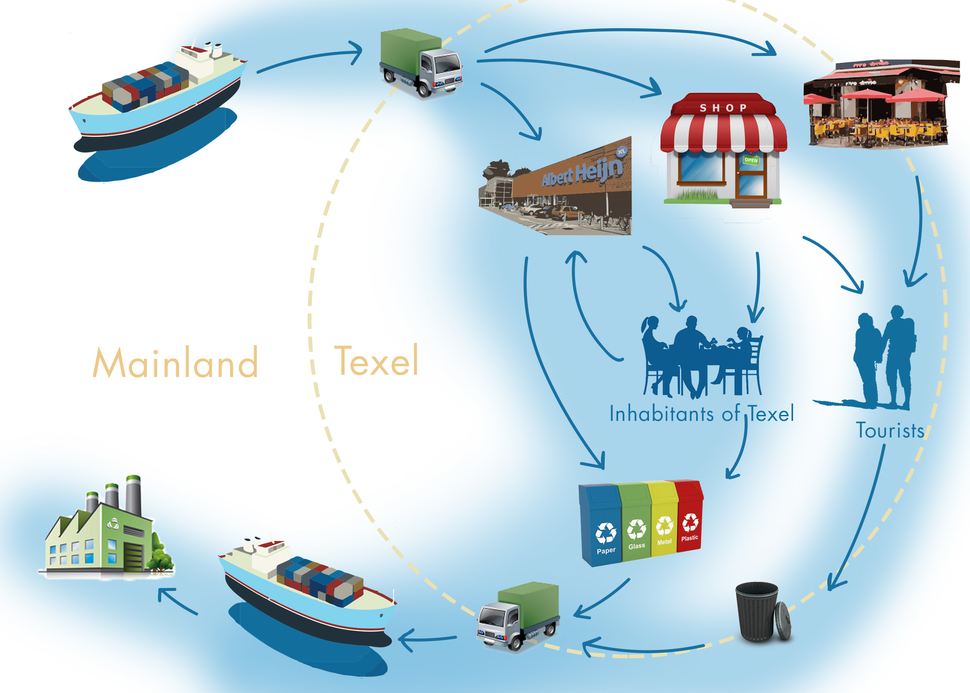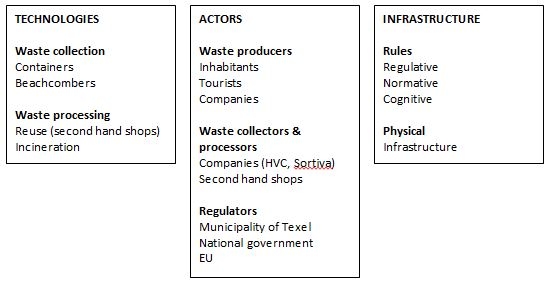1.2.1 The subsystem waste in The Netherlands
The average household waste production of a Dutch person is 500 kg per year, which is almost four times as much as in 1950. About 78% (392 kg) of this amount is inorganic waste. Only 51% of the total waste is collected separately, the remaining 49% is collected as unsorted waste. About 33% of the total waste is processed for incineration, which means that 67% is recycled or reused in some kind of way (recycling & reuse, composting, landfilling, separation afterwards. But the household waste is only a small part of the total waste stream: 85% of all waste comes from companies. That is another 3,079 kg waste per person in the Netherlands every year (CBS, 2014).
Texel has an average household waste production per person of 675 kg per year, which is considerably higher. It is highly probably that this is caused by the tourists industry on the island, since tourists are known to produce a lot of waste. Also on Texel 78% of the total waste is inorganic and 51% is collected separately (CBS, 2014). Data on waste from companies on Texel are not known.
1.2.2 Elements of the sociotechnical subsystem
This sociotechnical subsystem consists of three main categories of elements: technologies, actors and infrastructure. With these three elements the subsystem will be described. In figure 1 these main elements can be seen. These elements cannot be seen separately and are interconnected.
Figure 1. Main elements of the sociotechnical subsystem waste
1.2.2.1 Technologies
A technology is the collection of waste by the beachcombers (strandjutters). They clean the beaches by collecting stranded or left materials.
Waste processing
There are several second hand shops that buy and sell used materials. Some of the waste is processed here. Texel does not have other facilities to process the waste themselves. If the waste is not locally reused, the waste is transported to the main land to be processed there.
We can assume that there a large quantity of the waste of Texel goes to one of the combustion plants of HVC. The activities of HVC also include second hand shops, recycling, fermentation and incineration with energy generation (Green Islands Network, 2015).Currently on Texel we can divide the technologies of the waste subsystem in waste collection and waste processing.
Waste collection
The household waste on Texel is collected separately by the cleaning services of the municipality. Residual waste is collected in grey mini containers and organic waste in green mini containers. They are collected every other week by the municipality. There are also public containers in every neighbourhood for paper/cardboard, plastic, glass, textiles and small chemical waste. Plastics are also collected in separate bags every two weeks at every house by the municipality (Texel, 2013).
1.2.2.2 Actors
The actors of the waste subsystem can be divided in waste producers, waste collectors & processors and regulators.
Waste producers
These are the actors that create the waste on the island, consisting of the inhabitants of the island, tourists visiting the island and companies on the island.
The inhabitants of the island like to keep the island clean, because they are proud of their place. But most of them don’t want radical changes in their everyday rhythm. They are looking for an easy way to deal with waste. Separation of different waste streams is now done at the source, at the inhabitants themselves. But the separation rate is not high enough yet, since only 50% is collected.
We can assume that most of the tourists visiting the island also want to keep it clean, so they can visit a clean island in the future again. For them it’s even more important that there is a simple way of dealing with the waste they create. But separating waste is a tough challenge for tourists, since most of the compostable waste at recreational homes has to be treated as regular waste, because it has not been separated well enough (Texel, 2013).
The companies on the island want to dispose their waste as cheap as possible and according to the rules. They follow the legislations and waste disposal management of the municipality. The municipality offers collecting services for waste of companies.
Waste collectors & processors
The main actors here are HVC and Sortiva. HVC provides all the waste management services for Texel. They collect and transport the waste to the transfer depot ‘The Hamster’, from where it is shipped to Alkmaar for incineration (Green Islands Network, 2015).
Sortiva is the company that recycles bulky items, rubble, plastics paper and glass, so that it can be reused for other products.
Regulators
The regulations are created by three governmental bodies: the municipality of Texel, the Netherlands and the EU.
The municipality is aiming for a sustainable and self-sufficient island in 2020. Their main interest in waste is to keep the island clean and to close the waste cycle. Keeping the island clean will help keeping the tourist industry running, which will benefit the whole island (financially).
Like the municipality itself, also The Netherlands is aiming to make Texel a sustainable island. This involves for example that the incineration process will be done on Texel, to generate energy and to reduce the costs and time for the transportation of waste.
1.2.2.3 Infrastructure
We can divide the infrastructure of the waste subsystem in different rules and the physical infrastructure.
Rules
The subsystem has several important rules and regulations. There are three types of rules: regulative, normative and cognitive (Geels, 2002).
Within the regulative rules we can distinguish six points on which the current policy focuses. These policies are derived from the ‘Grondstoffenplan’ from the municipality of Texel and they are based on European and national directives. The main principle in the European directives is that the polluter pays. The national directive guides us to a priority list: prevention – re-use – re-cycle – incineration – landfill. So waste should be treated as much as a resource as possible and those who doesn’t obey these rules have to pay for the disposal of the waste.
The six points that we can distinguish are as followed:
- Waste disposal: Glass, compostable waste, paper, plastics and other wastes are all collected separately. The municipality aims to get 65% separation rate in 2020.
- Waste re-use: Texel aims to re-use 70% of its waste in 2020, which is more than the national Dutch aim of 65% by 2020. The purpose of this is to have as much of the waste processed on the island itself. Otherwise it should be transported as efficient as possible to the main land.
- Waste amount: The one who pollutes pays. The general waste taxes are asked from every citizen. There is a difference in single households, family homes and recreational homes. Companies have to pay an amount depending on the type of waste and the amount of collections per year. Currently it is cheaper to have ‘general waste’ collected than ‘compostable waste’.
- Waste collection systems camouflage: Plans for this are developed in the form of an underground collecting system, which should be finished by 2015.
- Waste in nature and streets: The new waste collection system has to help the prevention of waste being dumped in nature and on the streets.
- Clean beaches: The companies located on the beach are responsible for cleaning their surroundings within 25 meters. The rest of the beach is under responsibility of the government that cleans it up according to the demand. At least twice a year the complete beach is cleared from any waste. Next to this, people can notify the government when waste has to be collected from a full bin, which will be done as soon as possible.
Normative and cognitive rules are hard to describe. Normative rules are about the norms in society and how society expects people to handle their waste. These rules are not written down, but it’s what it generally accepted. For example, you should not leave waste on the beach. Cognitive rules are more about how people look at waste, how they interact with it (Geels, 2002). An example is the ‘jutterscultuur’.
Physical
The transport of waste on land is down by vehicles via the roads. After the waste is collected it is transported by boat to the main land.

